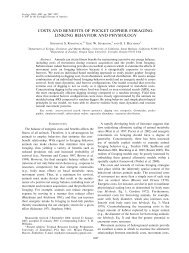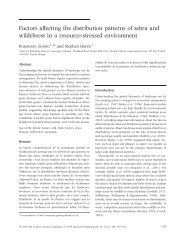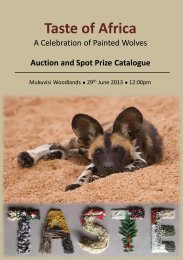The feeding ecology of the aardvark Orycteropus afer - ResearchGate
The feeding ecology of the aardvark Orycteropus afer - ResearchGate
The feeding ecology of the aardvark Orycteropus afer - ResearchGate
You also want an ePaper? Increase the reach of your titles
YUMPU automatically turns print PDFs into web optimized ePapers that Google loves.
140 W. A. TAYLOR ET AL.Table 1. <strong>The</strong> overall contents <strong>of</strong> <strong>aardvark</strong> faecal samples at TdR from 1996to1998 (standard deviation in paren<strong>the</strong>ses). Mean % were calculated from 12individual <strong>aardvark</strong>s and a total <strong>of</strong> 350 faecal samples. <strong>The</strong>y were calculated in <strong>the</strong>following way: for each faecal sample, species numbers were converted into percentagesand an average obtained from all samples for each <strong>aardvark</strong>. <strong>The</strong>se were <strong>the</strong>nclumped with o<strong>the</strong>r <strong>aardvark</strong> averages to give <strong>the</strong> overall average. % occurrence is <strong>the</strong>percentage <strong>of</strong> faecal samples in which a prey species was foundMean % Range % Occurrence IVAnoplolepis spp. 68)4 (27)1) 0–100)0 95)8 65)50Monomorium albopilosum 7)4 (11)8) 0–92)2 78)6 5)81Dorylus helvolus 2)8 (11)1) 0–90)3 23)9 0)67Messor capensis 1)1 (3)3) 0–35)3 55)1 0)61Formicidae sp. 1 0)4 (1)3) 0–11)6 17)7 0)07Crematogaster spp. 0)4 (3)3) 0–50)4 8)5 0)03Camponotus spp. 0)3 (1)2) 0–16)4 27)4 0)08O<strong>the</strong>r species 0)3 (1)7) 0–27)7 15)5 0)05Solenopsis punctaticeps 0)3 (2)7) 0–34)2 4)5 0)01Monomorium havilandi 0)1 (0)4) 0–3)4 46)6 0)05Pheidole spp. 0)1 (0)1) 0–1)1 7)5 0)01Formicidae sp. 2 0)1 (0)5) 0–4)3 7)0 0)01Formicidae sp. 3 0)1 (0)4) 0–6)9 6)7 0)01Trinervitermes trinervoides 15)3 (22)3) 0–98)9 82)5 12)63Hodotermes mossambicus 2)9 (10)6) 0–100)0 44)4 1)29Importance value (IV)"(Mean % * % Occurrence)/100.Table 4 shows average monthly variation in <strong>aardvark</strong> faecal contents for one year. Inevery month Anoplolepis spp. were <strong>the</strong> most abundant prey, followed by T. trinervoidesand M. albopilosum. Within all species <strong>the</strong>re was considerable variation between monthsbut <strong>the</strong>re were no apparent seasonal patterns.Seasonal differences in <strong>the</strong> predation <strong>of</strong> A. custodians and T. trinervoides weretested statistically. May, June and July data were clumped as winter, while November,December and January data made up summer. Average percentages from nine <strong>aardvark</strong>swere used. For Anoplolepis spp. <strong>the</strong>re was no seasonal difference (t"0)84,df."16, p"0)41), while for T. trinervoides <strong>the</strong>re was evidence for a seasonal difference(albeit not at <strong>the</strong> 0)05% level) (t"2)02, df."16, p"0)06). In winter <strong>aardvark</strong>sate more T. trinervoides than summer.In 1997 T. trinervoides comprised an average <strong>of</strong> 64% soldiers and 36% workers in <strong>the</strong>faeces. Worker numbers increased in winter <strong>the</strong>n decreased again in <strong>the</strong> followingsummer. January and December had <strong>the</strong> lowest proportions <strong>of</strong> workers (25% and 24%respectively) while <strong>the</strong> winter months May to July had an average <strong>of</strong> 39%. October was<strong>the</strong> only month when workers outnumbered soldiers (54% workers).Soldiers occurred in <strong>the</strong> faeces in larger numbers than expected (χ 2 "3184, df."1,p(0)001). Expected values were calculated by multiplying <strong>the</strong> percentage <strong>of</strong> a casteavailable (25% soldiers, 75% workers) (Adam, 1993) by <strong>the</strong> total number <strong>of</strong> soldiers andworkers in <strong>the</strong> faeces.Feeding observationsAt TdR <strong>aardvark</strong>s fed at night and exclusively from ant and termite nests. Ground feedsfor ants were mostly 5–30 cm deep, while digs as deep as 2 m were observed for <strong>the</strong>





